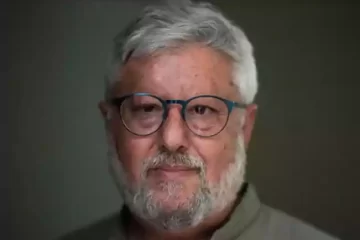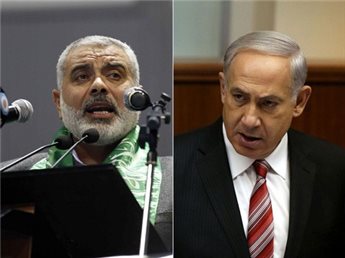At the weekly demonstration last Saturday night in Jerusalem where I stand with the Gush Neged Hakibush (The Bloc Against the Occupation) holding a sign that says: “There is no democracy with occupation” we found ourselves under siege by a small group of Israeli police. Amid the more than 10,000 protesters was a group of about 200 Israeli Jews surrounding a large sign that said: “First they took the Palestinian flag and I didn’t speak out.”
In the center of the group were several people holding the black, white, green and red Palestinian flags. Uniformed and plain-clothed Israeli police attempted to break the human wall protecting the flags in order to confiscate them. In an instant, I was pulled back in time to my summers as a teenager in the Zionist summer camp Tel Yehuda in upstate New York.
We played a game back then where the counselors would wake us in the middle of the night, we would dress quickly and quietly and march out of the bunk. We gathered together and were told in whispers that our kibbutz, circa 1947, was surrounded by British soldiers and that we had to protect our flag. What a night of intrigue and excitement. We young Zionist campers were going to save the flag of the Jewish people so that the Jewish state could be born.
There have been Palestinian flags held by demonstrators at the weekly protests in Tel Aviv, but this was the first time in 20 weeks that we saw Palestinian flags at the Jerusalem demonstration. The background was the attempt of the Israeli government to pass another right-wing bill that would bar waving Palestinian flags on Israeli campuses. The bill was introduced by far-Right Otzma Yehudit MK Limor Son Har-Melech, and would institute campus bans on waving Palestinian flags. According to the draft legislation, students caught violating the ban would be suspended for 30 days for the first violation, and then for subsequent violations would be blocked for five years from either receiving a degree in Israel or having a foreign degree recognized. For us at the demonstration, protecting the Palestinian flag was equal to protecting our democracy and our democratic right to free expression. It is also a symbol of solidarity with the struggle of the Palestinian people for freedom and liberation from our brutal and illegal occupation.
The Palestinian flag in Israel
THE PALESTINIAN FLAG in Israel was illegal throughout the first intifada. Israeli soldiers would often stop young Palestinians and order them to climb electricity poles in order to remove Palestinian flags hung there by the youth protesting against the occupation. Israeli soldiers would force men of all ages to scrub walls or paint over Palestinian flags adorning walls of homes and shops all around the West Bank and Gaza.It is hard for me to imagine a less useful duty for a soldier of a national defense force. As the flags were erased, many more would appear within hours in the very same places. It was such a futile exercise. The same thing once again continues now.
On November 29, 1989, during the first year of the First Intifada, a small group of people (including me) from the Dai Lakibush (Enough of the Occupation) movement, held a demonstration (that no one saw) in front of the buildings of the pre-state National Institutions: World Zionist Organization, the Jewish Agency for Israel, Keren Kayemeth LeIsrael and Keren Hayesod at the junction of King George Street and Keren Kayemet in Jerusalem. We wanted to mark the day that the United Nations voted to partition British Mandatory Palestine into two states – a Jewish state (Israel) and an Arab state (Palestine). At that time, I honestly believed that the 29th of November should be marked as a national holiday in Israel, because it was the day that the State of Israel was officially granted a birth certificate. We held hand-painted signs with the slogan “Israel-Palestine Two States for Two Peoples,” and we painted two flags – an Israeli flag and a Palestinian flag. About 15 minutes after we started a police van arrived at the scene. Two policemen got out, pointed at us one-by-one counting until eight, and demanded: “Get into the van.” They took us to the Russian Compound police station where we spent most of the night. Eventually, before morning, we were released after we signed some papers. This was my first time being arrested.
Several weeks later, I received by special delivery a registered mail notification that I was being charged with identifying with a terrorist organization. From that time onward for several years, I wore a button on my collar with the two flags which I had made in a factory in Bethlehem. I would give them out to anyone who was willing to wear it.
The Oslo Declaration of Principles
ON SEPTEMBER 13, 1993 while the Oslo Declaration of Principles was being signed on the lawn of the White House with the famous handshake between Yasser Arafat and Yitzhak Rabin, thousands of Palestinians marched out of Orient House, the equivalent of the Palestinian National Institutions in Jerusalem. They were led by Palestinian leader Faisal el Husseini carrying Palestinian flags, olive branches and flowers which were distributed to Israelis they met along the path of their march for peace along the border between west and east Jerusalem.
With the Oslo agreement, the Palestinian flag was legalized in Israel. Many Israeli journalists then correctly referred to the flag as the Palestinian flag and not the flag of the PLO as almost every Israeli journalist today calls it. Hundreds of official meetings then took place between Israeli and Palestinian ministers, security people, parliamentarians, and even the prime ministers of Israel and the president of the Palestinian Authority. In most of these meetings, Israeli and Palestinian flags appeared side-by-side, equal in status, and symbolizing the hope and dream of peace. Even Prime Minister Benjamin Netanyahu was photographed – on more than one occasion – in the official residence on Balfour Street in Jerusalem, with the flags of Israel and Palestine behind the two leaders from Israel and Palestine. (Was it more difficult for Netanyahu to be seen with a Palestinian flag, or for Yasser Arafat to come to Balfour Street, named after the British foreign secretary who offered Palestine to the Jewish people as a Jewish national home?)
We have regressed so much since those times when Israeli leaders could stand with a Palestinian flag next to an Israeli flag. Today, in 2023, there is probably little viability to the two states solution, nonetheless, the Palestinian people exist both on this land and in the diaspora. Their numbers virtually equal that of Israeli Jews on this land and Jews in the Jewish Diaspora.
These millions of Palestinians in Palestine, Israel and around the world have their flag. They have their identity, their pride, their narrative and their hopes for a future of equality, liberation and independence. The violent acts of policemen trying to confiscate Palestinian flags during an Israeli demonstration for democracy are not going to remove the Palestinian identity from those millions of people.
Those people will remain our neighbors for as long as the State of Israel exists. I can assure the Israeli government and police that the more they try to confiscate the Palestinian flags the more they will appear. Israeli settlers have returned to the futile efforts to remove Palestinian flags from the territories that they occupy. They cannot succeed. Palestinians will continue to fly their flag proudly.
And now Israeli Jews, who fully comprehend the true meaning of democracy, will proudly wave the Palestinian flag. Some of them will wave both flags and some only the Palestinian flag. Yes, this is a provocation, but it is less about “identifying with a terrorist organization” or with the enemy, and more about protecting our democratic rights for free expression and even more so, to push harder for the recognition that there really cannot be democracy with occupation.


